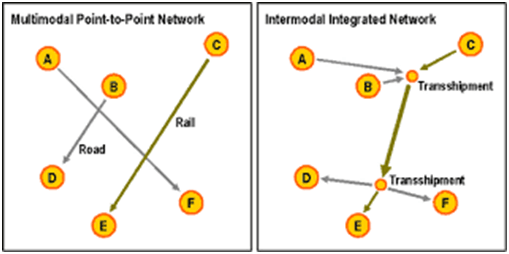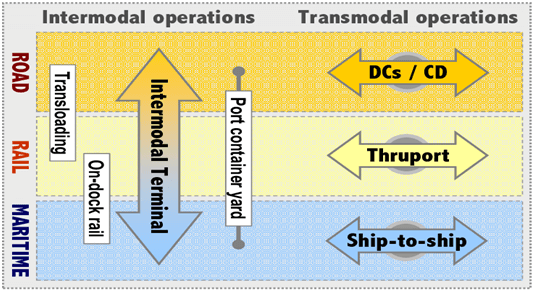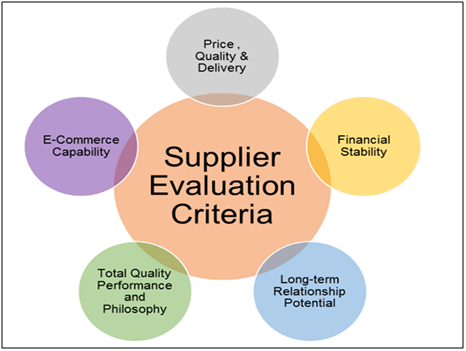Intermodal freight transport involves the transportation of freight in an intermodal container or vehicle, using multiple modes of transportation (e.g., rail, ship, and truck), without any handling of the freight itself when changing modes. The method reduces cargo handling, and so improves security, reduces damage and loss, and allows freight to be transported faster. Reduced costs over road trucking is the key benefit for inter-continental use. This may be offset by reduced timings for road transport over shorter distances.
Table of Contents
Intermodal Freight Transportation Demand
Over the past few years, capacity has been squeezed with driver shortages, increased demand, and increased fuel prices. Intermodal transportation has provided one such solution. While traditionally carriers strictly sell the advantages of their own modes, this approach to transportation is quickly becoming outdated in our global society.
Shippers will need to take a more integrated approach to keep pace with economic expansion and consumer demands. Today, logistics executives are taking the same approach to addressing the capacity squeeze by integrating the different modes of transportation: rail, truck, air, and sea. With the economy going through one of its slowest periods of expansion in history, shippers are exploring different ways of integration before everything ramps back up.

The most successful integration undertaking has been with intermodal rail. Shippers have realized that intermodal rail proactively addresses the need to meet both current and future business demands as the economy continues to expand.

Implementing Intermodal Logistics Strategies
1. Research and Evaluate Potential Providers
There are numerous types of intermodal service providers in the market. Asset and non-asset intermodal providers are much different in structure and resources than asset and non-asset truckload providers. The key in the research and intermodal provider evaluation phase is to gather as much information as possible from various intermodal providers to leverage the collective knowledge with information gathered in the education step to further develop the ultimate intermodal solution.

2. Intermodal Providers Perform Freight Analysis
There is tribal knowledge within organizations that will need to be accessed at this phase for the best intermodal analysis. This is not a pricing review, but an analysis of dock operation and equipment requirements at origin and destination, combined with an analysis of the company’s lanes. Not all lanes will have intermodal solutions. The output at this stage will be a blue print of the lanes that will be used for intermodal providers to bid the intermodal lanes.

3. Obtain Pricing and Transits
During this step, you may need to revisit the vision of success you had for yourself and management at the very beginning. Just remember to circle back around with management to help walk them through the new version of success and what caused it to change.
4. Implement Intermodal Solution
After the freight analysis is completed shippers tend to get excited with the savings potential and want to go all-in. Suggestion is to fight this all-in urge and work with the selected intermodal providers identified in the pricing and transit step to develop a phased in solution starting with the simplest dock need and best intermodal service lanes.
5. Evaluate Outcome Against Success Goal
With the intermodal implementation plan now in motion, it is time to evaluate the outcomes against the initial definition of success. With the analysis, tweak the program and continue to implement additional lanes until the full plan is in place.
6. Continue to Evaluate
The intermodal ramp network continues to evolve, as does a shipper’s inbound and outbound requirements, so do not think this is a one-time process. Continue to invite your intermodal providers in to learnt more and help evaluate where other solutions could potentially fit within your transportation network. Areas to also evaluate intermodal is for line hauls on LTL consolidations: line hauls on pooling points: and trans loading ISO boxes in and out of ports for better control of inventory placement and cost savings.
Benefits of using Intermodal Transportation
o Lower Cost
Shippers can take advantage of lower rates, more predictable pricing, and the flexibility of loading and unloading goods in a dropped trailer environment, which reduces handling costs.
The full content is only visible to SIPMM members
Already a member? Please Login to continue reading.
References
Gathy Macharis. (2006). “Planning problems in intermodal freight transport: Accomplishments and prospects”. Retrieved from https://www.tandfonline.com/doi/full/10.1080/03081060802086397, accessed 12/09/2019.
Jeffrey R. Brashares. (2013).“Intermodal transportation’s strategic advantage”.
Retrieved from https://www.inboundlogistics.com/cms/article/intermodal-transportations-strategic-advantage, accessed 11/09/2019.
Marketing. (2017). “The benefits of intermodal shipping”. Retrieved from https://www.logisticsplus.net/the-benefits-of-intermodal-shipping, accessed 11/09/2019.
Stanley Teo, ADLSM. (2017).“Impact of the Emerging 5G Network Technology on Logistics and Supply Chain management”. Retrieved from SIPMM: https://publication.sipmm.edu.sg/impact-of-the-emerging-5g-network-technology-on-logistics-and-supply-chain-management, accessed 10/09/2019.
Tan Shi Ying Jacelyn, ADPSM. (2019). “Technologies for an effective healthcare supply chain”. Retrieved from SIPMM: https://publication.sipmm.edu.sg/technologies-effective-healthcare-supply-chain, accessed 10/09/2019.

